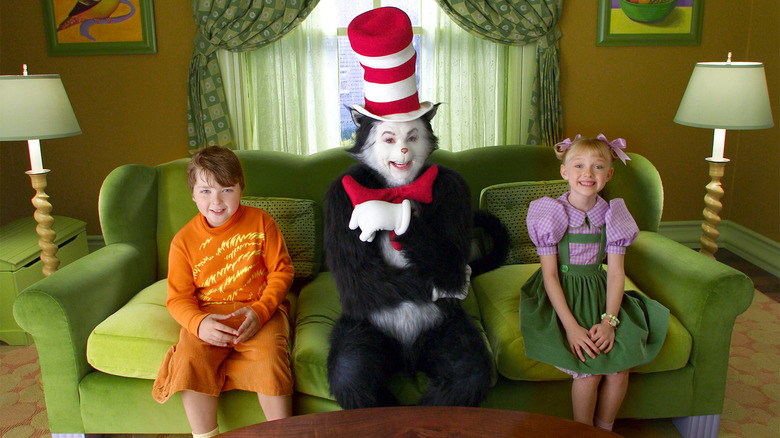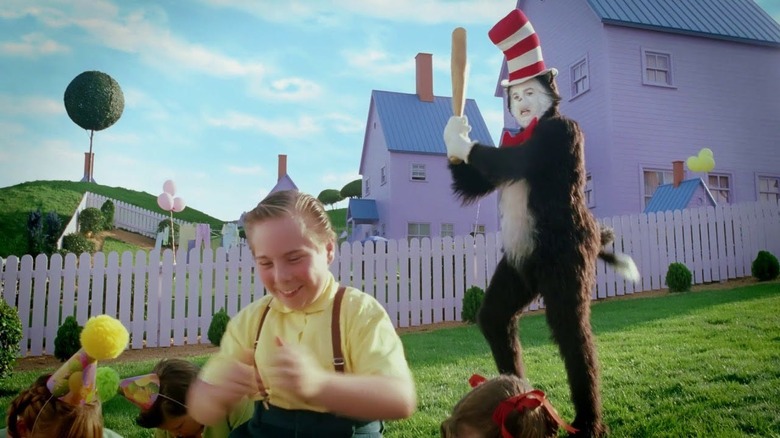One Of Mike Myers' Biggest Career Flops Is Getting New Attention On Netflix
After the success of Ron Howard's "How the Grinch Stole Christmas" (a hit so big even the 2018 animated remake broke box office records), it was a no-brainer for Hollywood to look to other Dr. Seuss books for inspiration for its next success. DreamWorks quickly set its sights on "The Cat in the Hat" and greenlit a live-action adaptation with a budget over $100 million, tapping another Canadian-born comedic A-lister to star in the film — in this case, Mike Myers, an actor who was at the peak of his career, starring in both the "Austin Powers" trilogy AND "Shrek" at the same time. The 2003 film also starred Spencer Breslin and Dakota Fanning, the former a popular actor with kids at the time thanks to "The Santa Clause 2" and the latter a phenomenal young actor too good for this disappointing project.
And yet, the film was so hated that Dr. Seuss' widow, Audrey Geisel, literally banned any more of Seuss' works from getting live-action film adaptations. Arguably even worse, it made it so, for a while, Illumination was the only studio making Seuss adaptations. "I think we succeeded in screwing it up for everyone else," director Bo Welch once told SYFY WIRE. Indeed, it was a colossal disaster that bombed at the box office (only making $133.8 million worldwide) and helped to derail Myers' career, in case you're wondering why he's made so many "Shrek" sequels since then.
But despite what critics and audiences may have thought more than 20 years ago, streaming has given every movie — no matter how bad — a chance to become a worldwide phenomenon for at least a couple of weeks. Sure enough, the time has come for the live-action "Cat in the Hat" to get a second chance at life thanks to Netflix.
Were critics wrong about The Cat in the Hat? Not really
It wasn't just the cast; "The Cat in the Hat" also had some impressive talent involved behind the camera. Welch, for one, had made a name for himself as the production designer on fantastical and memorable movies like "Beetlejuice" and "Edward Scissorhands." (He also married Catherine O'Hara after the pair met on the set of the former film.) Unsurprisingly, he wound up bringing a distinct, Tim Burton-esque visual flair to his Seuss adaptation. Combined with the movie's infamous reputation, that was seemingly enough to entire audiences to give it a shot on Netflix, with FlixPatrol reporting "The Cat in the Hat" hit the streamer's number five spot in the U.S. in the first week of August.
Indeed, in the years since the initial release of "The Cat in the Hat," the movie has gathered a sort of cult following and even undergone something of a reevaluation. Now, there are some who praise the absurdity of the film's visual palette — shot by legendary Oscar-winning DP Emmanuel "Chivo" Lubezki — and the over-the-top, bizarre script credited to (among others) Alec Berg, creator of "Silicon Valley" and co-creator of "Barry." Do they have a point?
Well, let me put it this way: "The Cat in the Hat" is the sort of film that makes you feel like you're awake during surgery. It's a nightmarish lucid dream made not for kids, but for people who hate kids. The cat himself is a grotesque monstrosity — a creature born of a fever dream who wreaks havoc like he's a demon let loose on the day of the apocalypse — and the actual film bears only the slightest of resemblances to the original book's plot.
Forget "The Mean One"; if there's any Seuss adaptation that deserves a full-blown horror remake, it's "The Cat in the Hat."

